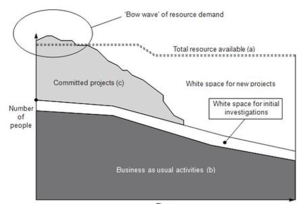In an earlier blog I talked about the three necessary conditions if you are to manage your resources effectively (see Link). Resource management is a hot topic in many companies and is the primary driver for them implementing programme and project management systems.
In this blog, I’ll talk about what I refer to as “white space” and why, if you haven’t got this, your company or organisation is in an unhealthy state. So what is “white space”? The gap between what your resources are committed to and the total resource you have available is ‘white space.’ It is the resources that you have not yet committed to a given activity or project. If you fulfil conditions 2 and 3 from my earlier blog, you will know your white space:
White space = resources available – resources already committed
In the very short term this should be small. It will grow as you look further into the future.
White space is fundamental to a organisation’s on-going health. If you haven’t any in the short to medium term, you are paralysed. You have no one available to change the business to meet new threats or exploit new opportunities unless you withdraw them from previously committed work. White space gives you the resources to effect change in the future.
‘We are in a fast moving environment’ is the common mantra nowadays. If this is truly the case, then you need to ensure that you have ‘white space’ resources ready to meet future needs. You know the people will be required but you are not yet sure exactly what for. If you have no people to change things, things won’t change.
White space must cater for two distinct needs:
● First, it must cover the need to undertake initial investigations from new proposals. People must be available at very short notice to do these and must be highly knowledgeable if the investigations are to have any value.
● Second, you need the resources to undertake the future projects or work.
Compare the former to a company putting a bid together – if this is done by inappropriate people, the timing of when bid and what bids are needed is unpredictable, the bid may be lost or the company may have committed itself to a financial disaster. Just because business projects are ‘internal’ it does not mean you need not apply the same rigour as you would with external matters. It’s your organisation’s future at stake in both cases.

The figure represents ‘white space’ in graph form. It could apply to a complete organisation, a division, a function or whatever. However, unless you can build this picture you will be taking risks every time you need to set off another initiative.
One of the challenges I have found is that many organisations plan on an annual basis and the financial controllers insist that every work item for the year is itemised and budgeted for, believing that this will ensure efficiency; they simply won’t allow “white space” and expect managers to have 20:20 forecasting vision . . . even in a fast moving environment. White space is what enables an organisation to be nimble, fast moving or agile (choose your own buzz word).
You can find out more about resourcing in Chapter 14 of the Programme and Portfolio Workout.
 The Programme and Portfolio Workout has been launched. Together with its companion, The Project Workout, this book aims to help you run your organization in a structured, yet agile way so you can meet your strategic goals and make sure all parts of your organization are aligned.
The Programme and Portfolio Workout has been launched. Together with its companion, The Project Workout, this book aims to help you run your organization in a structured, yet agile way so you can meet your strategic goals and make sure all parts of your organization are aligned.


